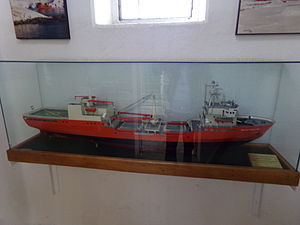ARA Bahía Paraíso
 Model of the Bahía Paraíso.
| |
| History | |
|---|---|
| Name | Bahia Paraiso |
| Builder | Astilleros Príncipe y Menghi SA |
| Yard number | 147 |
| Laid down | 1979 |
| Launched | 1980 |
| Commissioned | 1981 |
| Decommissioned | 1989 |
| Identification |
|
| Fate | sank in waters off Palmer Station, Antarctica |
| General characteristics | |
| Length | 133 m (436 ft 4 in) |
| Beam | 20 m (65 ft 7 in) |
| Propulsion | 2 × Sulzer diesel engines 12,000 hp (8,900 kW), dual shaft, 2 screws |
| Speed | 18 knots (33 km/h; 21 mph) |
| Complement | 124 crew + 252 troops or 124 crew + 84 passengers |
| Aviation facilities | hangar and flight deck for two helicopters |
ARA Bahía Paraíso was an Argentine Navy auxiliary ship that sank in 1989, 2 miles (3.2 km) from Palmer Station at Arthur Harbor, Antarctica,[1] resulting in a 170,000 US gal (640,000 L; 140,000 imp gal) oil spill.[2][3]
Construction and design[edit]
Bahía Paraíso was ordered by the Argentine Navy on 27 February 1979[a] as a supply ship for use in Antarctic waters. The ship was launched from the Argentine shipyard Astilleros Príncipe y Menghi SA on 3 July 1980, entering service on 3 December 1981, with the pennant number Q 6.[5]
Bahía Paraíso was 130.7 m (429 ft) long overall and 120.0 m (393.7 ft) between perpendiculars, with a beam of 19.5 m (64 ft) and a draught of 7.0 m (23.0 ft). The ship had an icebreaking hull. Displacement was 9,200 t (9,100 long tons) full load. Two diesel engines rated at a total of 15,000 shp (11,000 kW) drove two controllable pitch propellers, giving a speed of 18 kn (21 mph; 33 km/h).[6]
The ship's holds had a capacity of 1,200 m3 (42,000 cu ft) dry cargo, with an additional 250 m3 (8,800 cu ft) refrigerated storage, together with 1200 tons of cargo fuel.[7] A flight deck and hangar for two helicopters was fitted. The ship had a crew of 124, and could carry 84 civilian passengers, who could be replaced by 252 troops.[4]
Operational history[edit]
This section needs expansion. You can help by adding to it. (December 2020) |
The ship operated as a naval auxiliary vessel from 1981 to 1986 and served in the Falklands War as a troop transport as well as a hospital ship.[8] It was involved in transporting troops to Leith Harbour prior to the Invasion of South Georgia.
After the war it reverted as an Antarctic supply ship for the Navy with occasional tourists on board. It was on a resupply trip with tourists to Antarctica at the time of the sinking off Anvers Island.[9] Passengers and crew were rescued by the Spanish Navy oceanographic research vessel Las Palmas.
See also[edit]
Notes[edit]
References[edit]
Citations[edit]
- ^ Sweet, Stephen T.; Kennicutt, Mahlon C.; Klein, Andrew G. (2015-02-20). "The Grounding of the Bahía Paraíso, Arthur Harbor, Antarctica". Handbook of Oil Spill Science and Technology. Hoboken, NJ: John Wiley & Sons, Inc. pp. 547–556. doi:10.1002/9781118989982.ch23. ISBN 978-1-118-98998-2.
- ^ "The world's frozen clean room". Business Week. 22 January 1990.
- ^ Smith, James F. (5 April 1990). "Struggling to Protect 'The Ice'". Los Angeles Times. Retrieved 2011-01-30.
- ^ a b Moore 1985, p. 17
- ^ Couhat & Baker 1986, p. 9
- ^ Couhat & Baker 1986, pp. 9–10
- ^ Couhat & Baker 1986, p. 10
- ^ "The Falklands War".
- ^ "Bahia Paraiso ARA [+1989]". wrecksite.eu. Retrieved 13 October 2022.
Bibliography[edit]
- Burden, Rodney A.; Draper, Michael I; Rough, Douglas A.; Smith, Colin R.; Wilton, David (1986). Falklands: The Air War. British Aviation Research Group. ISBN 0-906339-05-7.
- Couhat, Jean Laybayle; Baker, A. D., eds. (1986). Combat Fleets of the World 1986/87: Their Ships, Aircraft and Armament. Annapolis, Maryland: Naval Institute Press. ISBN 0-85368-860-5.
- Moore, John, ed. (1985). Jane's Fighting Ships 1985–1986. London: Jane's Yearbooks. ISBN 0-7106-0814-4.
Further reading[edit]
- "Buque Polar A.R.A. "Bahía Paraíso"". Histarmar. Retrieved 23 December 2020.
